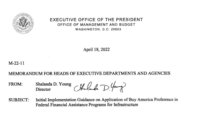Following up on an announcement from President Joe Biden in his State of the Union address, the Office of Management and Budget has issued a new proposed guidance on implementing Infrastructure Investment and Jobs Act provisions broadening the scope of Buy America requirements on federally funded infrastructure projects. The new guidance could lead to more types of construction materials to be covered by Buy America requirements.
In his Feb. 7 speech, Biden said, "Buy American has been the law since 1933. But for too long, past administration–Democrat and Republican–have fought to get around it. Not anymore."
Construction and transportation officials say they support efforts aimed at boosting U.S. manufacturing. But they say the new OMB guidance, published in the Federal Register on Feb. 9, raises a number of questions.
Comments are due by March 13 on the OMB guidance.
Brian Turmail, Associated General Contractors of America vice president for public affairs and strategic initiatives, told ENR via email, "The federal government continues to create uncertainty as it relates to new Buy America requirements, and at a time when most of the country will soon be entering construction season."
"We're still seeking clarity on a number of items," says Rich Juliano, American Road & Transportation Builders Association general counsel.
Buy America mandates go back decades. The domestic-preference requirements for iron, steel and some types of manufactured products pre-date the IIJA.
But that statute expands the domestic-preference scope. Folded into the IIJA is the text of the Build America, Buy America Act, which still requires use of domestic iron, steel and manufactured products but adds construction materials to the Buy America list on federally funded infrastructure projects.
OMB last April 18 issued initial guidance for implementing the IIJA Buy America provisions. That April document lists five types of construction materials that are to be covered by Buy America requirements: non-ferrous metals, plastic and polymer-based products, glass, lumber and drywall.
The new guidance continues to include those materials and adds three materials to the Buy America list: composite building materials, fiber optic cable and optical fiber.
Weighing Possible Add-Ons
In the new guidance, OMB also asks for comments about whether it should add still other construction materials to the roster of those that are Buy America-covered. The new document specifically refers to paint, stains and other coatings that are "applied at the work site," as well as to brick and engineered wood products.
Regarding coatings, Jim McDonnell, American Association of State Highway and Transportation Officials director of engineering, said in an interview that zinc coatings used in galvanizing steel are in widespread use on highway projects, including bridge components and light poles. "Even nuts and bolts are galvanized." he says.
But the U.S. lacks a huge domestic supply of zinc and some other metals, McDonnell says.
Aggregates and Other Exclusions
The text of the IIJA specifically excludes from Buy America several paving-related materials: cement and cementitious materials, aggregates such as stone, sand and gravel; and aggregate binding agents or additives.
The National Stone, Sand & Gravel Association and other groups pushed to have those exclusions included in the final text of the IIJA.
But in a surprising move, the new guidance appears to raise the subject of a possible change related to those excluded materials.
In the new document, OMB is asking for comments about how to deal with combinations of the excluded raw materials with other materials that result in a new one that has different properties from those of its individual components. ARTBA's Juliano said in an interview, "We were somewhat surprised to see that in there."
As of Feb. 10, NSSGA said it was still reviewing the new guidance.
But in a Feb. 8 statement—issued after Biden's State of the Union Buy America statement—Michael Johnson, the association’s president and chief executive officer, said, “Regardless of [the President’s] comments, the Biden administration still must follow the law as intended.”
AGC's Turmail said that the new OMB proposal also includes expanded definitions of the terms "manufactured products" versus "construction material" and broadened domestic manufacturing requirements for products under the "construction materials" category.
Turmail said, "Some of these changes seem to contradict OMB's [April] guidance, which federal agencies and state partners have been utilizing to formulate their policies to date."
He added, "Should these proposed changes come into effect, it would force agencies and their partners to reevaluate all of their [Build America, Buy America Act] policies and documents."
Turmail also said a separate Feb. 1 update from the Federal Highway Administration listing questions and answers about applying Buy America requirements in the federal-aid highway sector "may already be at odds with OMB's updated guidance."Industry Seeks Gradual Rollout
AASHTO's McDonnell said,"The state DOTs are supportive of the intent of Buy America—very much so."
He added, "It's the transition to the American-made products that they're concerned about—how quickly it goes, whether industry is ready, whether projects will be slowed down for lack of materials that are [Buy America] compliant, whether prices will go up."
McDonnell and ARTBA's Juliano say that any Buy America changes that may result from the proposed guidance should be rolled out at a measured pace.
McDonnell said, "Taking a hard line and flipping a switch would be problematic, but a gradual progression would be great."




Post a comment to this article
Report Abusive Comment